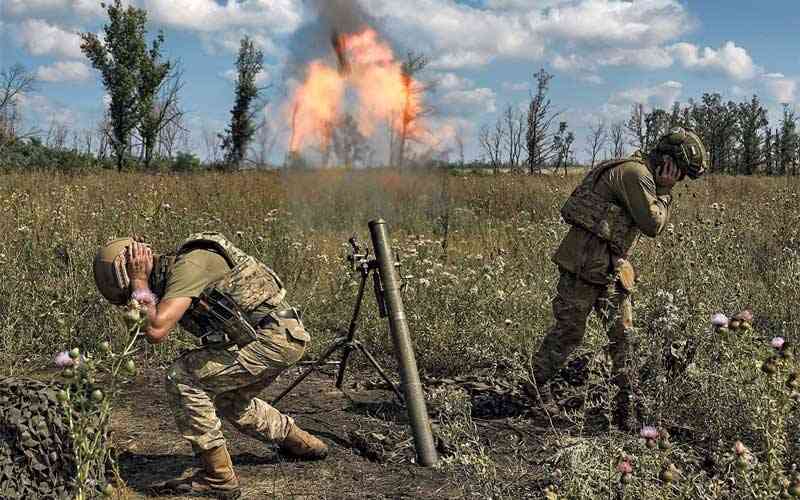
On September 10, the great breakthrough was underway. “The Ukrainians went forward again,” said breathless reports from the frontlines. “The Ukrainian Armed Forces are moving west of Novoprokopovka, east of Verbovo and between Novoprokopovka and Verbovo, expanding the breakthrough zone.”
Fifty days later, those obscure villages are still being mentioned every day as the location of ongoing clashes between Ukrainian and Russian forces. The “Big Push” has stalled and the Russian lines have held. Both sides are making local attacks along the length of the 900-km front, but nobody is going anywhere fast.
This matters much more for the Ukrainians, for three reasons. First, if it really has become a war of attrition, Russia’s population is more than three times higher and its economy (thanks to oil and gas) is 10 times bigger. Without a lot of foreign help with money and military supplies, Ukraine cannot possibly win.
Secondly, that help must come from countries that are sympathetic, but whose vital interests are not at stake in the war. To keep them committed, Ukraine has to demonstrate on a regular basis that it is winning, or at least has a good chance of winning.
Thirdly, the outbreak of war between Israel and Hamas in the Middle East, while a much smaller event with almost no risk of escalation to the nuclear level, is far more resonant emotionally for the big Western powers. For Americans, in particular, the Russia-Ukraine war has already fallen off the news agenda.
Even if there were a rapid resolution to the Gaza conflict — possible, but not likely — the Ukrainians are stuck in a military stalemate unless they can figure out what went wrong with their great offensive and fix it. Figuring it out is the easy part.
Ukraine does not have air superiority even over its own territory, and Nato will never let it have aircraft that could deliver that capability because they could also hit Russian territory. (The long-promised, long-delayed F-16s are 40 years old.)
Without air superiority, the Ukrainians cannot do Nato-style deep penetrations by fast-moving armoured forces. They have to rely on the more plodding approach of the Russian army, which has long experience of fighting without complete control of the skies.
- Lukaku becomes the most expensive player ever
- Lukaku becomes the most expensive player ever
- Ukraine's Zelenskiy warns Europeans to brace for bleak winter
- Ben Stiller and Sean Penn latest Americans banned from Russia
Keep Reading
Such tactics can succeed, but the Russian doctrine relies on dividing your force into two echelons: first-line units to make the breakthrough, and operational reserve units to develop it.
The first-line units do the lengthy, costly, exhausting business of chewing their way through deep enemy defences. Then, if and when they have opened up a breach, the reserve units race through to exploit it while the worn-out first-line troops just hold the shoulders of the breach open.
The attackers will take very heavy casualties in the first phase, but that is paid back with interest when the operational reserve pours through the breach and starts tearing up the defending forces from behind. At this point, even the enemy’s entire front might collapse.
But what if the first-line units struggle to make that initial breakthrough? Maybe there are just too many mines, enemy drones everywhere directing artillery that protects those minefields, movement possible only at night.
Then you have to commit some of your reserve units to help the initial breakthrough attempt. Do too much of that, however, and you may not have enough reserves left to exploit the breakthrough when you finally achieve it.
That is clearly what happened to the great Ukrainian offensive. They finally got through most of the minefields and the “dragon’s teeth” by early September, but they ran out of reserves. They have just been bouncing back and forth between Verbove and Novoprokopovka for the past eight weeks.
The Ukrainians don’t have the numbers, and they probably won’t have the numbers. On the other hand, the Russians continue to demonstrate that they may have the numbers, but they don’t have the skill or the will to break through themselves.
So it becomes a waiting game now, with no clear path to victory for either side. If we can think of this situation as the First World War in miniature, then 20 months into the war brings us to early 1916.
What followed in 1917 were more offensives, of course, but much more importantly huge mutinies in the French, Italian and Russian armies as the stalemate lengthened, the casualties mounted ever higher and the sheer futility of the whole enterprise struck home.
So which army’s morale is worse, the Ukrainian or the Russian? Which leader looks more insecure, Zelensky or Putin? A second presidential term for Donald Trump would confound everybody’s calculations, but the odds still favour Ukraine.
- Dyer is a London-based independent journalist. His new book is titled The Shortest History of War.






